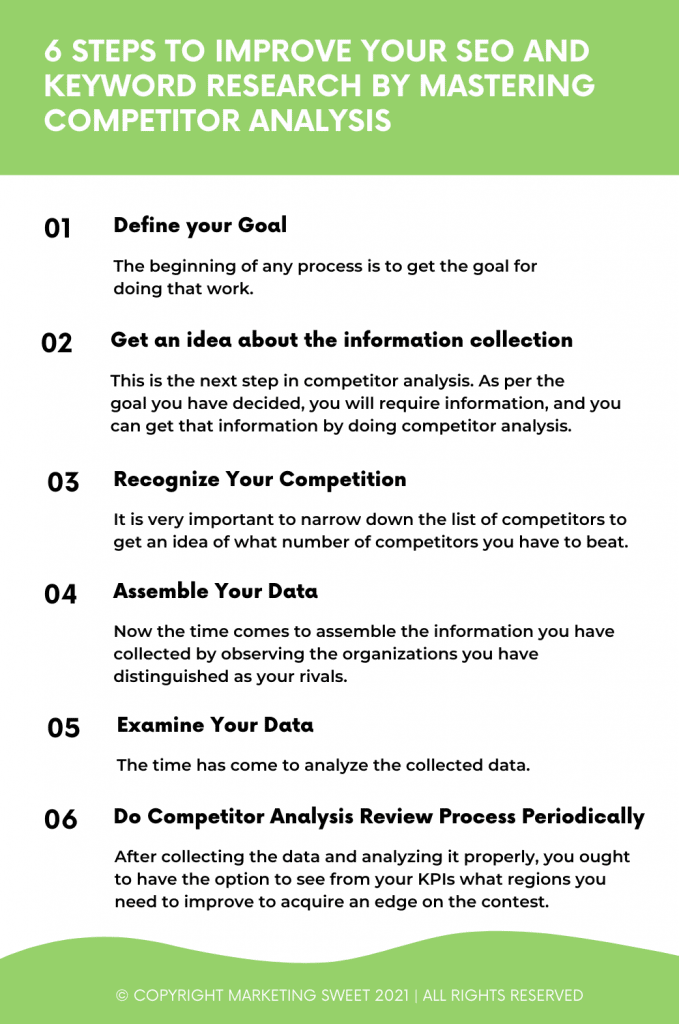SEO is the process of providing quality and quantity traffic to the website. Doing competitor analysis in this field is very much effective. You will get the right path to get ahead in your market specialty. You will find that some of the business marketers concur that serious examination of competition practice is significant or vital for achieving success in business. 6 Steps to Improve Your SEO and Keyword Research using mastering Competitor Analysis. However, most organizations aren’t sure how to do it. Most of the markets are not good at doing the competitors’ analysis. They do not know the right way to apply the competitors’ strategies.
Figuring out how to improve your competitors’ analysis can give your business an edge over most opponents who are battling with dominating this strategy. Here are six stages to assist you with improving the SEO by mastering competitor analysis.
1. Define your Goal
The beginning of any process is to get the goal for doing that work. If you have the right goal, then you have a map in your mind of how things will work and what you have to do to achieve that goal. Then, you will collect information and resources according to that. From an SEO perspective, there can be different goals. Such as improving the branding of your product and services, generating more traffic on a particular set of keywords for which your competitors are already ranking, creating more social followers, likes and shares, making your user experience more satisfying, developing a higher conversion rate and many more. As per the goal, you can focus on the competitor analysis and achieve your goal.
2. Get an idea about the information collection.
This is the next step in competitor analysis. As per the goal you have decided, you will require information, and you can get that information by doing competitor analysis. There are different sources from which you can collect the desired information.
- Social media profiles such as Facebook, Twitter, Instagram, Snapchat, and LinkedIn.
- Content available on competitors’ websites, such as FAQs, ebooks, blog posts, PR, and white papers.
- Online advertising and promotion sources such as pay-per-click ads, videos, slideshows.
- Webinars, podcasts, press releases, and online articles are also a good source of information
- You will get the most effective information from Search engine data, such as keyword rankings, page authority rankings
- You can get the customer data from your own customers or your competitor’s customers through interviews, surveys, and polls.
According to your goal, you will give priority to the data to get the goal. For example, if you aim to improve your website’s content, you can do an analysis of your competitor’s website content source. Or, if you want to increase the number of followers on your social profile, then you can check the SEO rankings of videos and social shares of videos, and according to that, you can also follow the same principle.
3. Recognize Your Competition
It is very important to narrow down the list of competitors to get an idea of what number of competitors you have to beat. Doing online business means there will be nearly hundreds or thousands of competitors, and it is not practically possible to do in-depth research about every competitor. So it is fruitful for you that you get the understanding of the top 10 competitors. The web design for your online business should be attractive so that you can gain trust with a Clean, Engaging Website Design. By doing this, you will get an idea of what the ranking factors of these websites are.
Whatever service or product you are going to offer to your customers, there will be more of the same websites already available on Google. Thus you should check the way of presentation of such websites that are ranking in the top position. To get the list of the ranking websites, you have to type the targeted keyword in the search engine, and then you will simply get a list of results. You can also take the help of tools such as SEMrush and others to get an idea about your top competitors

4. Assemble Your Data
Now the time comes to assemble the information you have collected by observing the organizations you have distinguished as your rivals. The more you can computerize your information assortment measure, the more proficient this progression will go. It is not necessary that all the desired data can be assorted automatically. However, for web and online media information gathering, you will get automated tools easily. For example, you can use Google Analytics, Facebook Insights and Twitter Analytics that permits you to robotize information assortment for explicit web search tools and social channels. Also, for users’ convenience to collect the information from different sources, there are tools such as SEMrush, HubSpot, XOVI and RankWatch. With these tools, you can easily coordinate your desired data. And finally, you can prepare all the collected data in the single sheet for analysis.
5. Examine Your Data
The time has come to analyze the collected data. To get the better analysis of the data, you will require some of the key performance indicators that have a direct relationship with the competitor analysis goal. For example, suppose you have set your goal to get a good number of followers on your social profile. In that case, you should check the data you have collected through Google Analytics, Facebook Insights, and Twitter Analytics. You have to set your own KPIs to get a better and satisfactory result. From time to time, you should update your collected data and KPIs so that you can perform better than your competitors.
6. Do Competitor Analysis Review Process Periodically
After collecting the data and analyzing it properly, you ought to have the option to see from your KPIs what regions you need to improve to acquire an edge on the contest. To make this reasonable, you should incorporate an occasional audit of your competitor analysis into your standard working systems. A decent method to do this is to schedule a planned booking to do a competitors analysis review. For example, you may make an everyday report on your organization’s SEO execution versus your rivals, audit this week by week in gatherings with your promoting group, and utilize this to graph progress toward a month to monthly objectives and make minor strategic changes. You can evaluate your month to month objectives and check whether or not you need to change them to remain focused on your yearly objectives. Doing these tasks periodically will one day help you achieve the objective.
- Simple website 6 – 12 pages: $3,500 to $7,000+
- Custom designed website 7 – 10 page: $5,500 to $9,500+
- WordPress Website: $6,000 – $11,000+
- eCommerce website: $7,500 to $20,000+
- Magento / Shopify: $10,000 – $22,000+
Conclusion
If you have to rank at a high position, keep updating your website from time to time. Also, it is very effective that you keep on checking the competitor’s strategy. You can do competitor analysis to generate a good number of leads on your website. Whenever you plan to launch your website, you must consider doing competitor analysis. You will get an idea of what your competitors are doing and how you can do better from that. Characterizing your objectives, figuring out what information to gather, distinguishing your opposition, gathering desired information, breaking down your information, and booking occasional surveys are useful steps toward getting a better ranking for your website. Executing these means will help you keep steady over the thing the rivalry is doing so you can make the changes you need to remain ahead in your market. You can consult with our professional SEO Adelaide team of Marketing Sweet. We have been in this industry for the past many years. Our SEO specialists understand the requirements of the users and then use search engine-friendly practices to rank your website.



